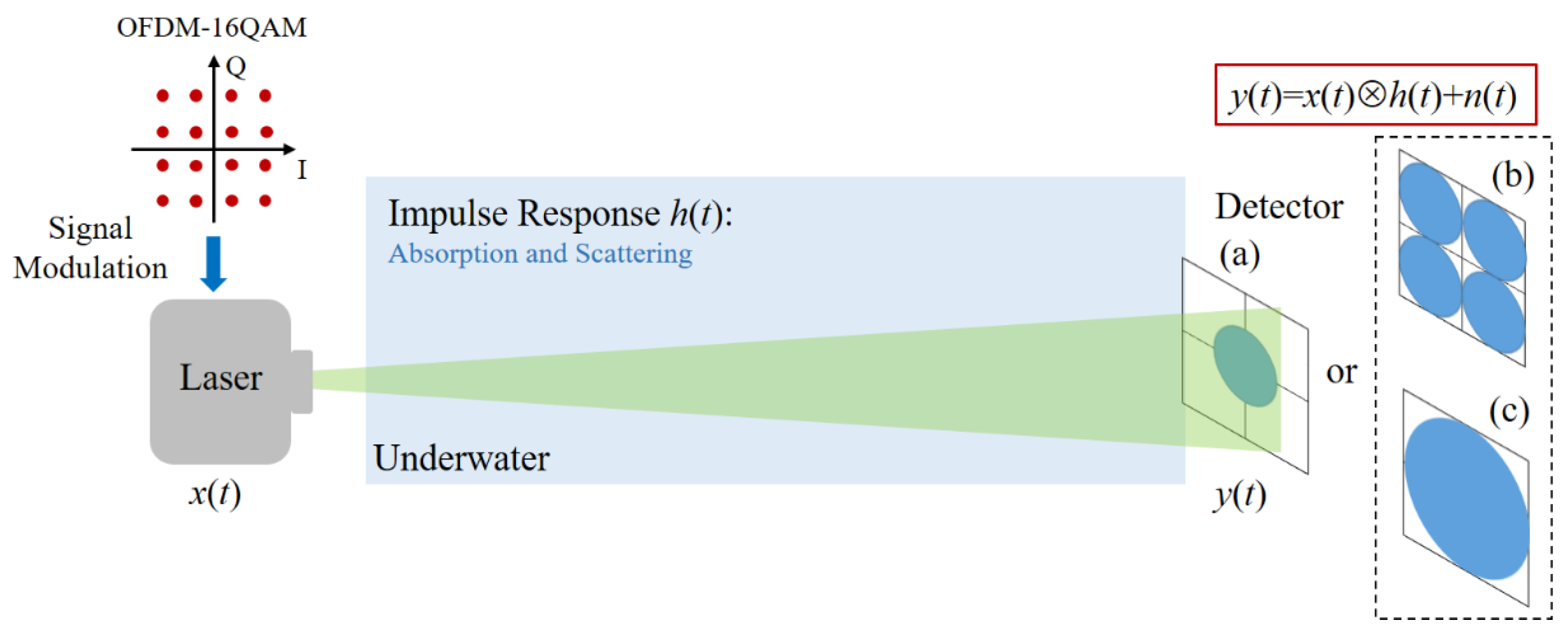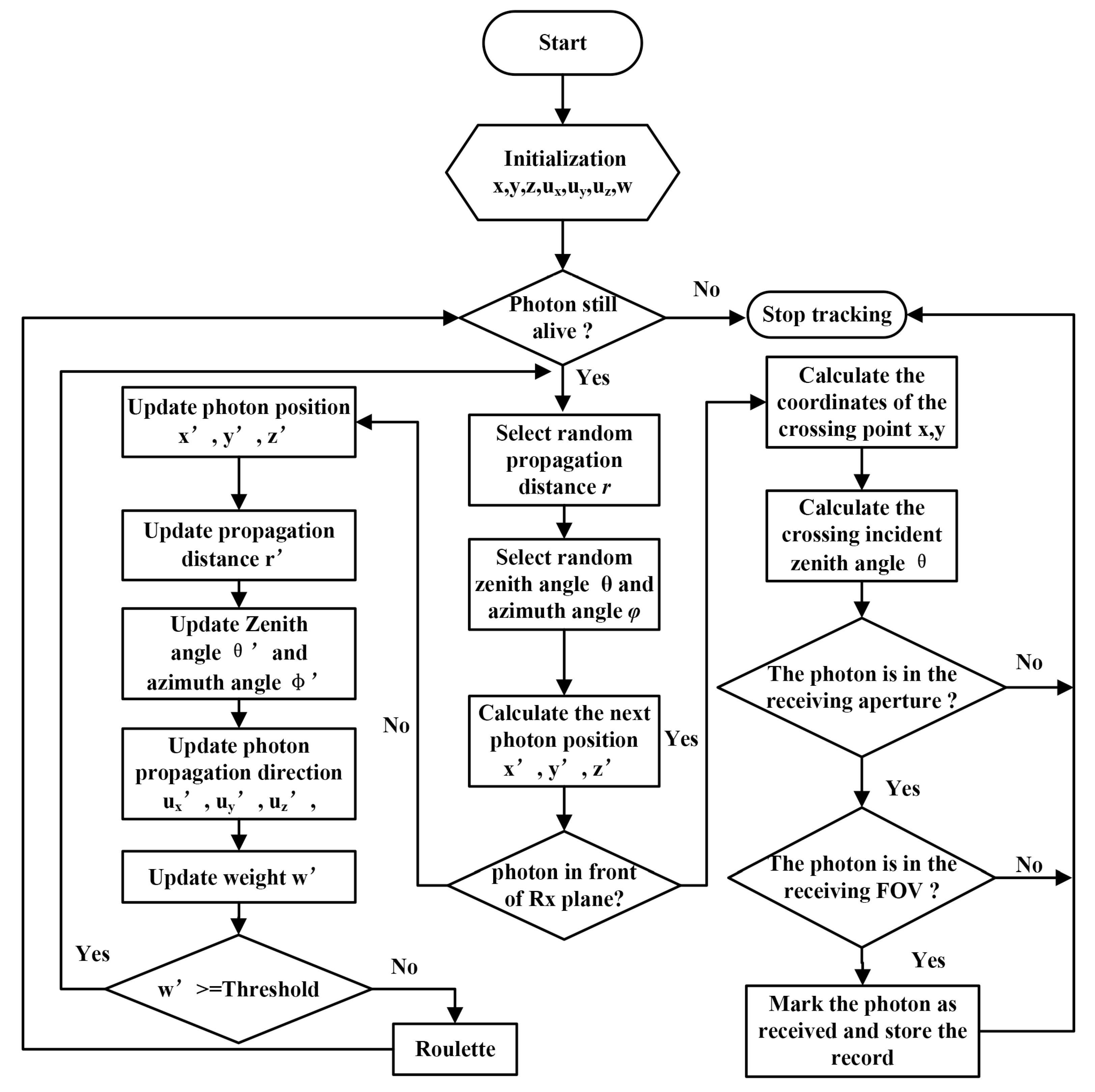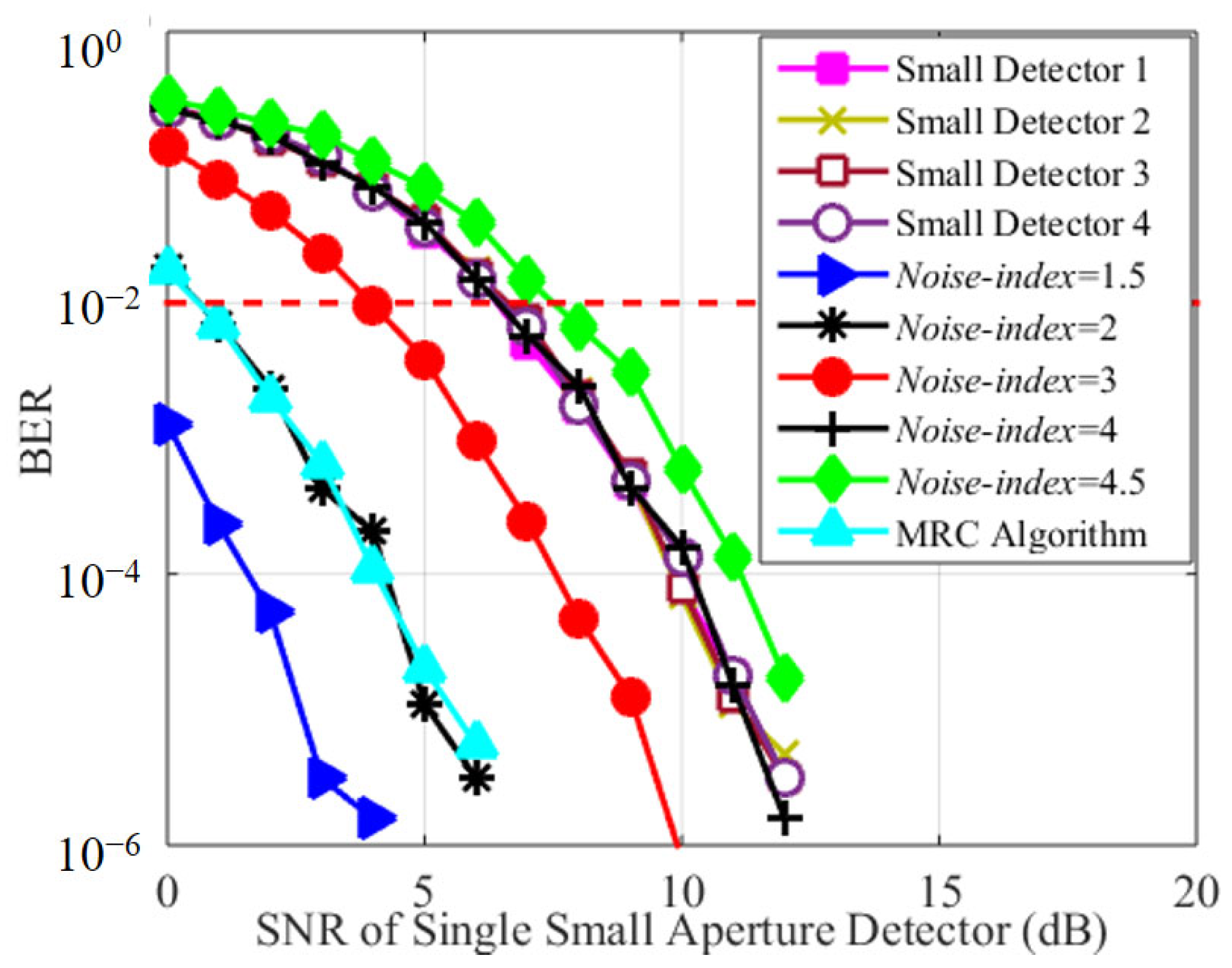Performance Evaluation of Maximum Ratio Combining Diversity Technology and Traditional System Based on Comprehensive Noise Analysis in Underwater Wireless Optical Communication
Abstract
:1. Introduction
2. Model and Methods
2.1. Underwater Channel Model
2.2. MC Simulation
- Propagation distance and position update
- 2.
- Photon weight update
- 3.
- Direction angle update
3. Simulation and Results
3.1. UWOC Channel Impulse Response
3.2. MRC Diversity Scheme
3.3. The LAD Scheme
- Noise-index < 2, i.e., 2n0 < 2n1−n1’. In this case, the performance of the LAD scheme is better than that of the MRC diversity scheme with a 2 × 2 detector array;
- 2 < Noise-index < 4, i.e., 2n0 < 2n1−n1’ and n1’ > 4n1. In this case, the performance of the MRC diversity scheme with a 2 × 2 detector array is better than that of the LAD scheme;
- Noise-index > 4, i.e., n1’ > 4n1. In this case, the performance of the SAD scheme is better than that of the LAD scheme.
4. Analysis
4.1. MRC Diversity Scheme with a 2 × 2 Detector Array
4.2. MRC Diversity Scheme with an M1 × M2 Detector Array
5. Discussion
6. Conclusions
Author Contributions
Funding
Institutional Review Board Statement
Informed Consent Statement
Data Availability Statement
Conflicts of Interest
References
- Zhao, M.; Li, X.; Chen, X.; Tong, Z.; Lyu, W.; Zhang, Z.; Xu, J. Long-reach underwater wireless optical communication with relaxed link alignment enabled by optical combination and arrayed sensitive receivers. Opt. Express 2020, 28, 34450–34460. [Google Scholar] [CrossRef] [PubMed]
- Oubei, H.M.; Li, C.; Park, K.H.; Ng, T.K.; Alouini, M.S.; Ooi, B.S. 2.3 Gbit/s underwater wireless optical communications using directly modulated 520 nm laser diode. Opt. Express 2015, 23, 20743–20748. [Google Scholar] [CrossRef] [PubMed]
- Zeng, Z.; Fu, S.; Zhang, H.; Dong, Y.; Cheng, J. A survey of underwater optical wireless communications. IEEE Commun. Surv. Tutor. 2016, 19, 204–238. [Google Scholar] [CrossRef]
- Kaushal, H.; Kaddoum, G. Underwater optical wireless communication. IEEE Access 2016, 4, 1518–1547. [Google Scholar] [CrossRef]
- Li, J.; Yang, B.; Ye, D.; Wang, L.; Wang, Y. A real-time, full-duplex system for underwater wireless optical communication: Hardware structure and optical link model. IEEE Access 2020, 8, 109372–109387. [Google Scholar] [CrossRef]
- Doniec, M.W.; Rus, D.L. BiDirectional optical communication with AquaOptical II. In Proceedings of the IEEE International Conference on Communication Systems (ICCS), Singapore, 17–19 November 2010; pp. 390–394. [Google Scholar]
- Doniec, M.; Detweiler, C.; Vasilescu, I.; Chitre, M.; Hoffmann-Kuhnt, M.; Rus, D. AquaOptical: A lightweight device for high-rate long-range underwater point-to-point communication. Mar. Technol. Soc. J. 2010, 44, 55–65. [Google Scholar] [CrossRef]
- Anguita, D.; Brizzolara, D.; Parodi, G. Building an Underwater Wireless Sensor Network Based on Optical: Communication: Research Challenges and Current Results. In Proceedings of the IEEE 2009 Third International Conference on Sensor Technologies and Applications, Athens, Greece, 18–23 June 2009; pp. 476–479. [Google Scholar]
- Ali, M.F.; Jayakody, D.N.K.; Gamage, P.T.P.; Dinis, R. Dual-Hop Underwater Wireless Optical Communication System. In Proceedings of the IEEE 95th Vehicular Technology Conference, Helsinki, Finland, 19–22 June 2022; pp. 1–6. [Google Scholar]
- Wang, T.; Yu, X.; Zhao, B.; Pang, D. Error Characterization of Differential Detection and Non-Differential Detection for MIMO UWOC Systems in Seawater Turbulent Channels. Photonics 2023, 10, 859. [Google Scholar] [CrossRef]
- Ali, M.F.; Jayakody, D.N.K.; Beko, M.; Correia, S. Performance Evaluation of Vertical VLC Link in Mixed Water Mediums. In Proceedings of the 6th Conference on Cloud and Internet of Things (CIoT), Lisbon, Portugal, 20–22 March 2023; pp. 195–199. [Google Scholar]
- Chen, X.; Lyu, W.; Yu, C.; Qiu, Y.; Chen, L.K. Diversity-reception UWOC system using solar panel array and maximum ratio combining. Opt. Express 2019, 27, 34284. [Google Scholar] [CrossRef] [PubMed]
- Wang, F.; Liu, Y.; Jiang, F.; Chi, N. High speed underwater visible light communication system based on LED employing maximum ratio combination with multi-PIN reception. Opt. Commun. 2018, 425, 106–112. [Google Scholar] [CrossRef]
- Al-Qahtani, F.S.; Zummo, S.A.; Gurung, A.K.; Hussain, Z.M. Spectral efficiency of maximum ratio combining (MRC) over slow fading with estimation errors. Digit. Signal Process. 2010, 20, 85–96. [Google Scholar] [CrossRef]
- Ahn, K.S.; Heath, R W. Performance analysis of maximum ratio combining with imperfect channel estimation in the presence of cochannel interferences. IEEE Trans. Wireless Commun. 2009, 8, 1080–1085. [Google Scholar] [CrossRef]
- Liu, W.; Xu, Z.; Yang, L. SIMO detection schemes for underwater optical wireless communication under turbulence. Photonics Res. 2015, 3, 48–53. [Google Scholar] [CrossRef]
- Boucouvalas, A.C.; Peppas, K.P.; Yiannopoulos, K.; Ghassemlooy, Z. Underwater optical wireless communications with optical amplification and spatial diversity. IEEE Photonics Technol. Lett. 2016, 28, 2613–2616. [Google Scholar] [CrossRef]
- Jamali, M.V.; Salehi, J.A. On the BER of Multiple-Input Multiple-Output Underwater Wireless Optical Communication Systems. In Proceedings of the IEEE 4th International Workshop on Optical Wireless Communications (IWOW), Istanbul, Turkey, 7–8 September 2015; pp. 26–30. [Google Scholar]
- Dong, F.; Xu, L.; Jiang, D.; Zhang, T. Impulse response modeling for underwater wireless optical communication links. IEEE Trans. Commun. 2014, 62, 226–234. [Google Scholar]
- Zhang, J.; Gao, G.; Li, J.; Ma, Z.; Guo, Y. Experimental demonstration and simulation of bandwidth-limited underwater wireless optical communication with MLSE. Photonics 2022, 9, 182. [Google Scholar] [CrossRef]
- Boluda-Ruiz, R.; Rico-Pinazo, P.; Castillo-Vazquez, B.; Garcia-Zambrana, A.; Qaraqe, K. Time-dispersion and signal attenuation analysis of underwater optical wireless communication links. In Proceedings of the IEEE Global Communications Conference (GLOBECOM), Waikoloa, HI, USA, 9–13 December 2019. [Google Scholar]
- Chen, D.; Liu, Y.; Ai, F.; Cao, M. Modeling and analysis of channel impulse response for underwater wireless optical communication. Opt. Eng. 2022, 61, 036102. [Google Scholar] [CrossRef]
- Petzold, T.J. Volume Scattering Functions for Selected Ocean Waters; Scripps Institution of Oceanography: La Jolla, CA, USA, 2007. [Google Scholar]
- Gabriel, C.; Khalighi, M.A.; Bourennane, S.; Léon, P.; Rigaud, V. Monte-Carlo-based channel characterization for underwater optical communication systems. J. Opt. Commun. Netw. 2013, 5, 1–12. [Google Scholar] [CrossRef]
- Cox, W.C., Jr. Simulation, Modeling, and Design of Underwater Optical Communication Systems; North Carolina State University: Raleigh, NC, USA, 2012. [Google Scholar]
- Li, J.; Ma, Y.; Zhou, Q.; Zhou, B.; Wang, H. Monte Carlo study on pulse response of underwater optical channel. Opt. Eng. 2012, 51, 066001. [Google Scholar] [CrossRef]
- Jaruwatanadilok, S. Underwater wireless optical communication channel modeling and performance evaluation using vector radiative transfer theory. IEEE J. Sel. Areas Commun. 2008, 26, 1620–1627. [Google Scholar] [CrossRef]
- Urick, V.J.; Bucholtz, F.; McKinney, J.D.; Devgan, P.S.; Campillo, A.L.; Dexter, J.L.; Williams, K.J. Long-haul analog photonics. J. Light. Technol. 2011, 29, 1182–1205. [Google Scholar] [CrossRef]





| Water Type | a (m−1) | b (m−1) | c (m−1) |
|---|---|---|---|
| Pure water | 0.053 | 0.003 | 0.056 |
| Clean water | 0.114 | 0.037 | 0.151 |
| Coastal water | 0.179 | 0.219 | 0.398 |
| Harbor water | 0.366 | 1.824 | 2.19 |
Disclaimer/Publisher’s Note: The statements, opinions and data contained in all publications are solely those of the individual author(s) and contributor(s) and not of MDPI and/or the editor(s). MDPI and/or the editor(s) disclaim responsibility for any injury to people or property resulting from any ideas, methods, instructions or products referred to in the content. |
© 2023 by the authors. Licensee MDPI, Basel, Switzerland. This article is an open access article distributed under the terms and conditions of the Creative Commons Attribution (CC BY) license (https://creativecommons.org/licenses/by/4.0/).
Share and Cite
Zhang, W.; Wang, L.; Wu, X.; Fei, L.; Peng, H.; Wen, K.; Zhao, Y. Performance Evaluation of Maximum Ratio Combining Diversity Technology and Traditional System Based on Comprehensive Noise Analysis in Underwater Wireless Optical Communication. Photonics 2023, 10, 1388. https://doi.org/10.3390/photonics10121388
Zhang W, Wang L, Wu X, Fei L, Peng H, Wen K, Zhao Y. Performance Evaluation of Maximum Ratio Combining Diversity Technology and Traditional System Based on Comprehensive Noise Analysis in Underwater Wireless Optical Communication. Photonics. 2023; 10(12):1388. https://doi.org/10.3390/photonics10121388
Chicago/Turabian StyleZhang, Weidong, Lulu Wang, Xiaying Wu, Li Fei, Han Peng, Ke Wen, and Yanli Zhao. 2023. "Performance Evaluation of Maximum Ratio Combining Diversity Technology and Traditional System Based on Comprehensive Noise Analysis in Underwater Wireless Optical Communication" Photonics 10, no. 12: 1388. https://doi.org/10.3390/photonics10121388




